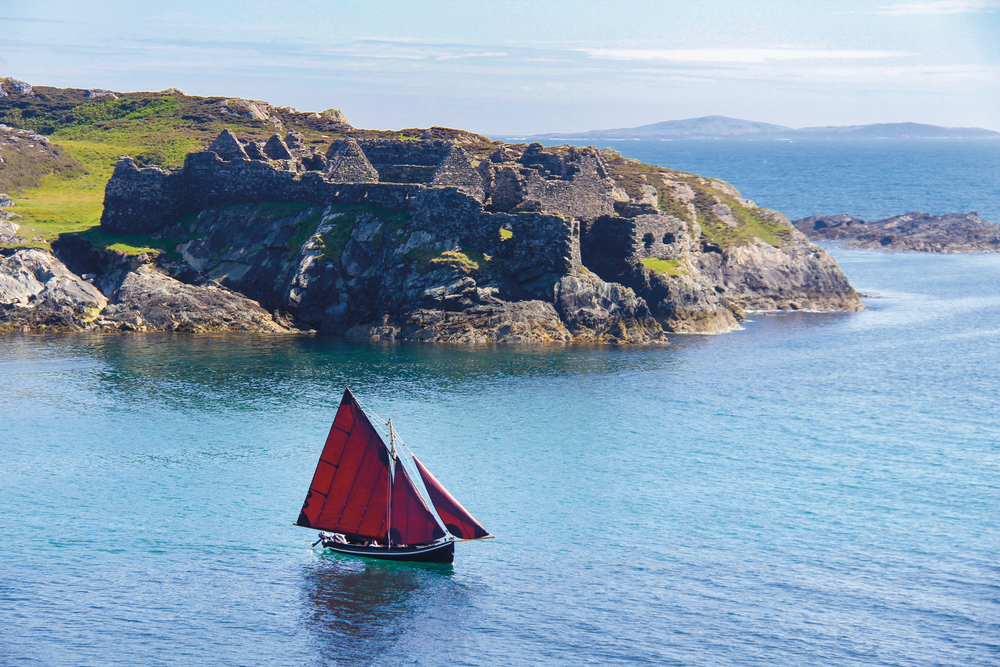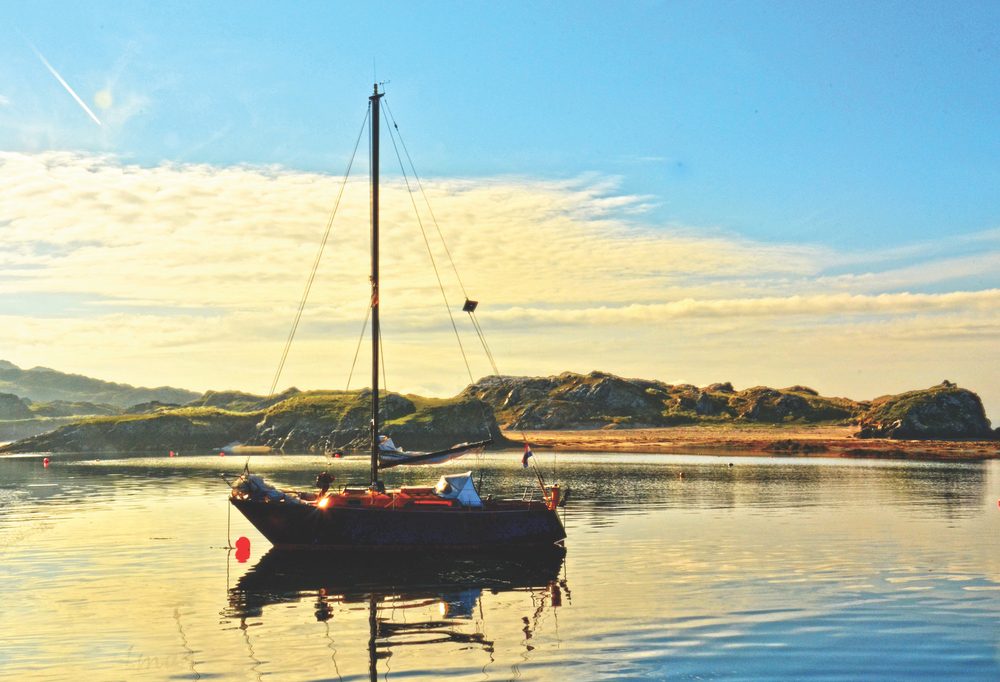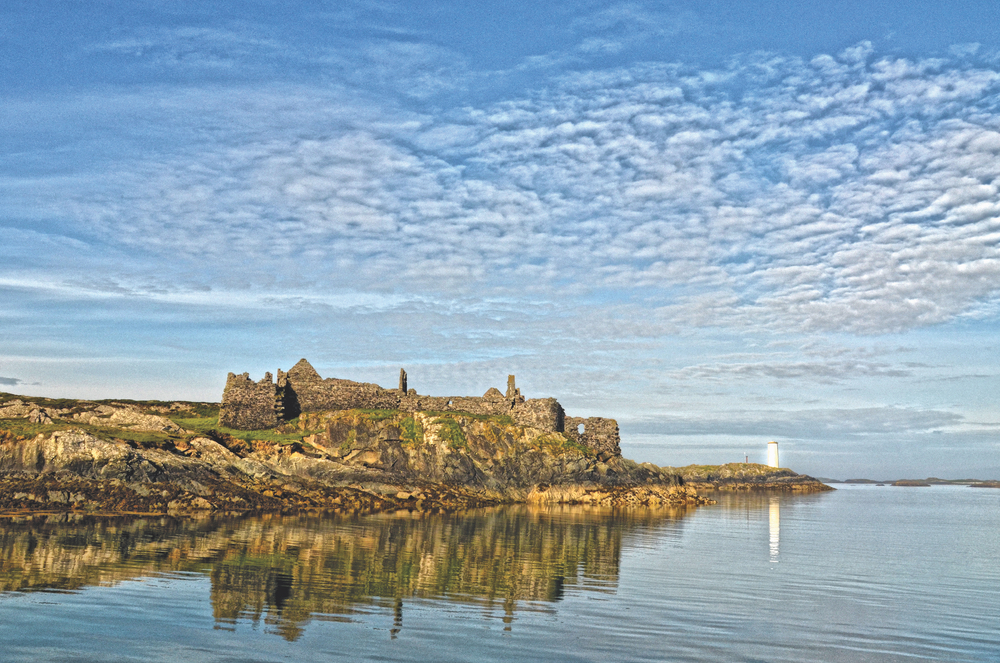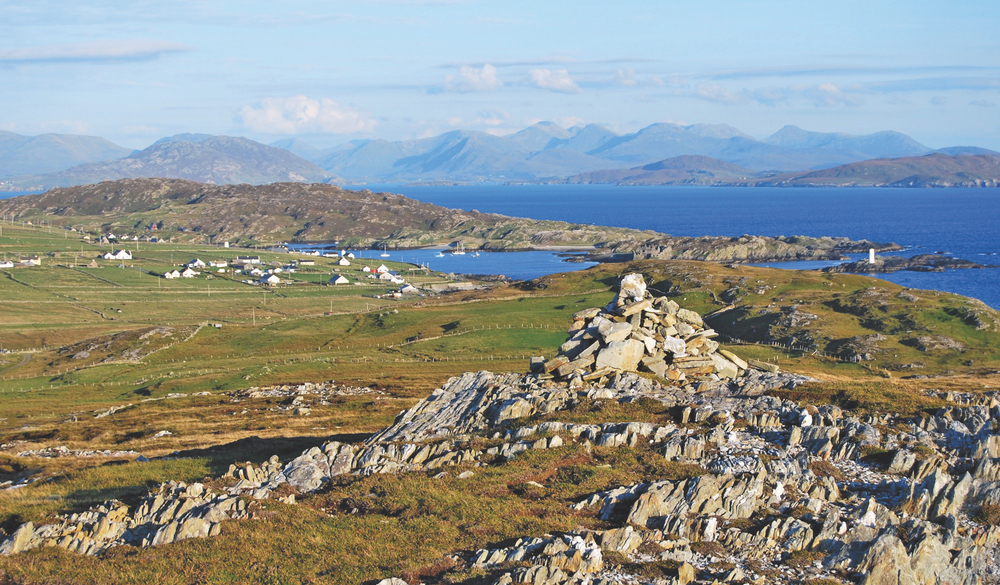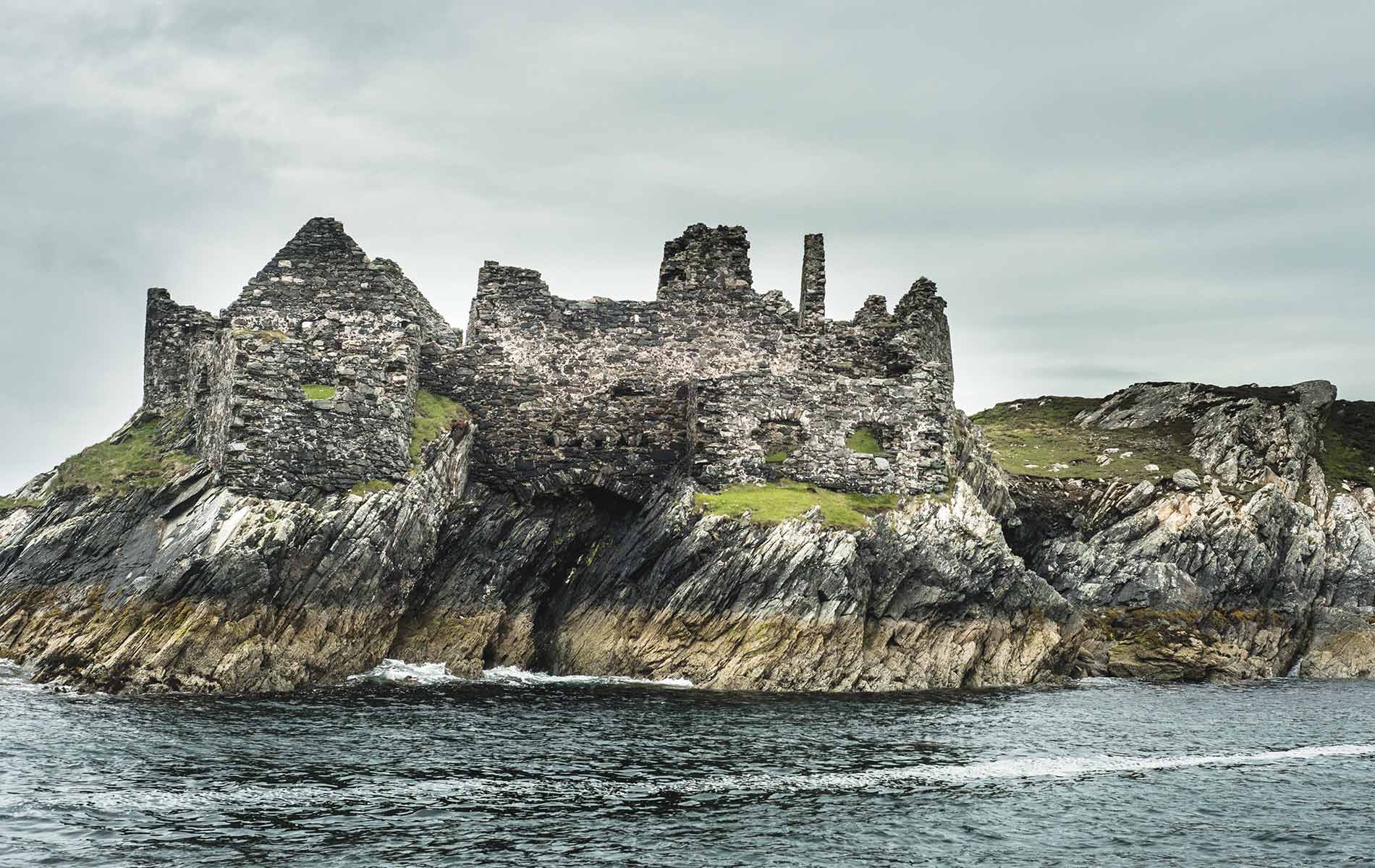
vie-magazine-connemara-life-inishbofin-island-hopping-hero
Photo by Mark Furniss
The Mystic Isle
By Luke Murray
Inishbofin is an island that lies roughly eleven kilometres off the coast of north-west Connemara. A vibrant star in the galaxy of islands that guards Ireland’s Wild Atlantic Way, it is a place that has borne witness to a history as rich and interesting as anywhere else in the country. It is a history informed by an abundance of archaeological riches still visible on the island today. It is also a history fired by the traditions of mythology and storytelling, which are an integral part of Irish culture.
The roots of its name alone (from the Irish Inis Bó Finne, meaning ‘Island of the White Cow’) give one a sense of the mysticism long associated with Inishbofin. The story goes that Inishbofin was a floating place, neither anchored nor tethered in one location, and eternally shrouded in an ocean mist. One night, two fishermen lost at sea in a heavy fog drifted ashore on this enchanted island. They lit a fire, its flames broke the spell that burdened the place, and at once the fog cleared. It was then they observed an old woman driving a white cow along a stony beach that separated the sea from a lake (this would be the North Beach of Inishbofin, between the ocean and Loch Bó Finne, the ‘Lake of the White Cow’). She struck the cow with a stick, and both she and the beast turned to stone. Oral tradition maintains that the woman and the white cow will emerge from the lake as a forewarning of impending disaster. From a beginning as haunting and mysterious as this, the island was never going to be a dull place—quite the opposite, as it turns out—but it is as enchanting now as it was then, ready to cast its spell on anyone lucky enough to find themselves here.
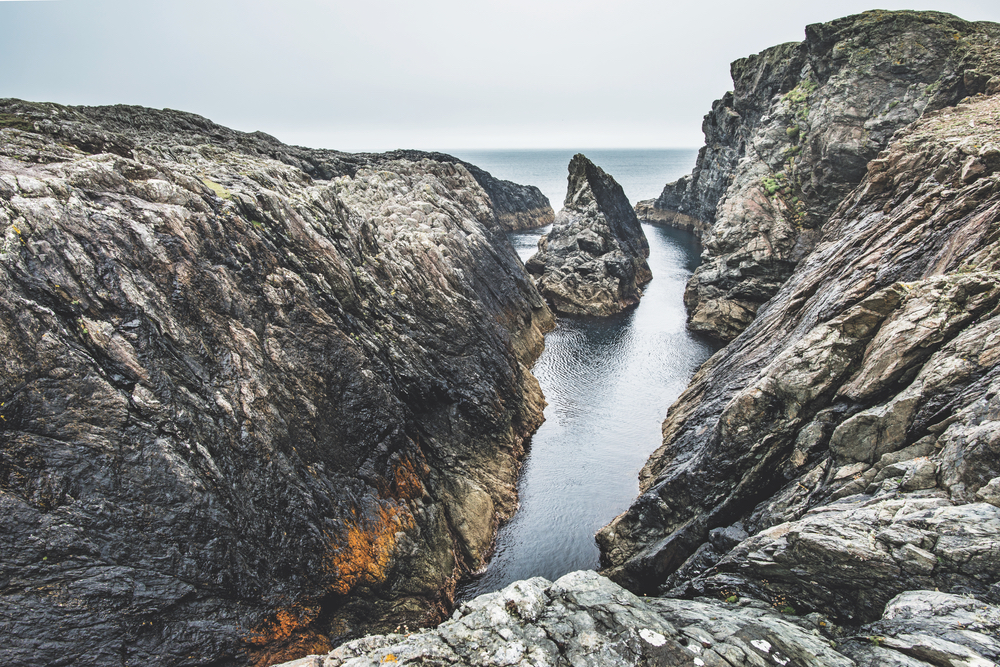
Dead Man’s Cove, Inishbofin
Photo by Mark Furniss
Setting aside the folklore, the island is known to have been inhabited for several thousand years. Evidence has been found of Bronze Age (c.3200 BC–c.600 BC) settlements, and the island has several promontory fort sites that are recognised as being from the Iron Age (1200 BC–1 BC). These are dotted around the coast of the island at strategic locations, the most formidable of which is at Dún Mór (‘Big Fort’) in Westquarter, a site located on the highest cliffs of the island. In terms of tangible recorded history, the first significant appearance of Inishbofin in the written record was in the seventh century. Saint Colman of Lindisfarne sought out the island for the creation of a monastery after a dispute with the Catholic Church in England. Originally from the west of Ireland, he left with his followers and came to Inishbofin in AD 665. A stone chapel was built on the site of his monastery in the fourteenth century and still stands today, now surrounded by the island’s graveyard.
The towering coves and cliffs of Westquarter and the northern coastline, carved by a furious ocean over millennia, provide a stark contrast to the sprawling golden beaches on the sheltered east side.
The famed pirate queen, Granuaile (Grace O’Malley), also appears in the history and traditions of Inishbofin. One site called Dún Gráinne bears her name, and folklore maintains that she controlled the island in alliance with a Spanish pirate, Don Alonzo Bosco. It is said they stretched a chain from her fort across the harbour’s mouth to his stronghold on the other side to entrap those who entered and also to keep out unwanted visitors. Plunder and misfortune were sure to follow for those who became snared inside.
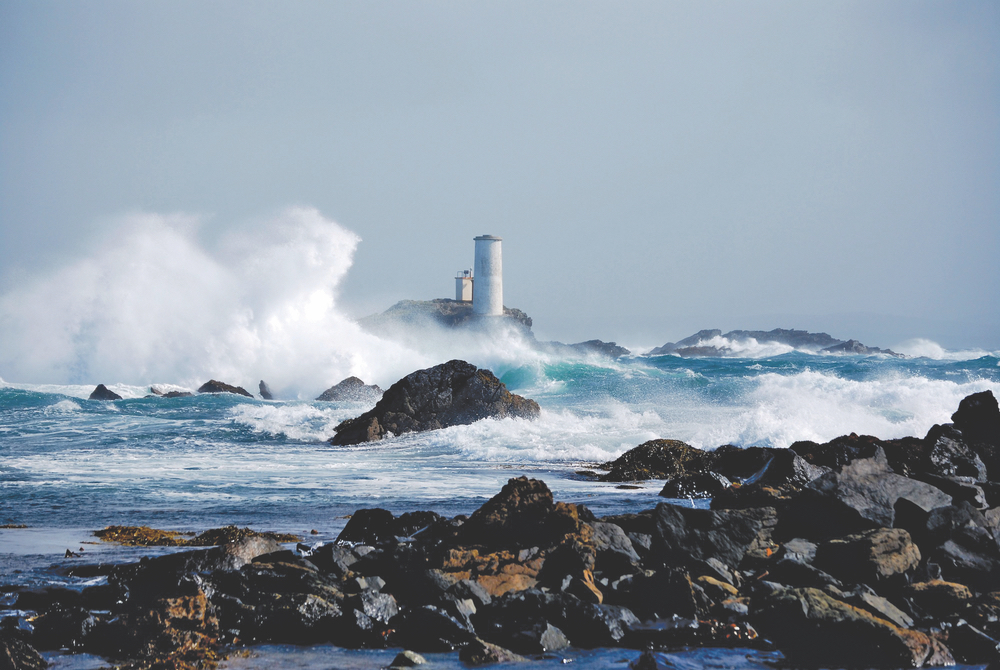
The Tower stands strong against the storms of winter.
Photo by Marie Coyne
Where Don Bosco’s settlement was reputed to have been, the still-impressive remains of Cromwell’s Barracks (commonly referred to as the Castle) can be seen now. Inishbofin was one of the last Royalist-held territories against the New Model Army of Oliver Cromwell’s Parliamentarians as they swept across Ireland, leaving devastation in their wake during the English Civil War in the mid 1600s. Upon the capture of Inishbofin, they built the imposing fortress that stands defiantly to this day, watching over the mouth of the island’s safe harbour nearly four centuries later. It was used as a staging post for Catholic priests who were being expelled from Ireland to the Caribbean.
Throughout its history, Inishbofin has sustained itself on the traditional industries of fishing and farming. It is difficult to imagine now, but at the height of its population in the nineteenth century, the island supported around a thousand people. Inishbofin was also used as a base for many more fishermen from the surrounding islands and the Connemara coast; however, the primary industry on the island today is tourism. This is a market that, from the first semi-regular passenger trips that the poet Richard Murphy ran in the 1950s, has slowly and steadily grown to accommodate around forty thousand visitors each year. Inishbofin receives visitors year-round, but the season really gets going at Easter, when all of the hospitality businesses throw open their doors once more to welcome guests, both old and new.
- An Inishbofin púcán, a traditional boat of Connemara, in full sail Photo by Marie Coyne
- The serenity of a safe harbor reflects the island’s beauty. Photo by Stephanie Salmon
- The ruin of Cromwell’s Barracks guards the harbour mouth on Inishbofin’s southern coast. Photo by Stephanie Salmon
- A glorious panoramic tapestry seen from atop Cnóc Mór Photo by Marie Coyne
For those with a thirst for adventure, Inishbofin is a place that each year seeks to offer more refreshment. To such spirits, each day can bring a new method of exploration and thrill-seeking: hire a bike and take to the road; spend a few hours on horseback, trekking the coast and the hills; experience a kayaking or snorkelling tour of the pristine Blueway Trail in one of Ireland’s most incredible natural harbours; take a guided historical walking tour and discover even more of the island’s heritage; charter an island-hopping rigid inflatable boat (RIB) tour and visit the seal colony; ramble along three National Looped Walks; spend some time getting hands-on with a visit to a working island farm; step back in time with the Heritage Museum; immerse yourself in the ornithological riches of the island with a bird-watching weekend—the list of wonderful activities goes on and on and grows each year.
All of this, however, merely touches upon what makes Inishbofin so special. A recent project initiated by the community and run by EcoTourism Ireland has brought a determination to promote tourism that is sustainable and environmentally conscious and that benefits the local economy. The island is moving toward being as self-sufficient as possible, reducing its impact in terms of waste production by running projects aimed at recycling materials, and generally trying to do things in the right way to ensure a future that does not negatively affect the beautiful natural environment. Inishbofin is Ireland’s first ‘Leave No Trace’ island, partnering with the Leave No Trace outdoor educational organisation to promote responsible tourism worldwide. It is the first Fairtrade Island in the Republic of Ireland and has developed its own unique Inishbofin Fairtrade coffee. The diverse schedule of festivals throughout the summer celebrates all that is best about every aspect of the island’s culture, including its music, arts, seafaring, and food. Indeed, the island is famous nationally as a centre for traditional Irish music through its indigenous musicians and also through the hundreds of visitors who come every year to perform. Inishbofin’s bars, restaurants, and hotels serve the finest of island produce where possible throughout the summer, culminating in the fantastic Bia Bó Finne Food Festival every October.
Above all else, it is the people that make the island such a special place. Locals will happily stop to talk and answer questions, provide advice, tell stories, and welcome visitors to these shores.
Above all else, it is the people that make the island such a special place. Locals will happily stop to talk and answer questions, provide advice, tell stories, and welcome visitors to these shores. Inishbofin people share their beautiful home with so many year after year, and yet they are unstintingly welcoming for all that. So step aboard the ferry, leave behind the cares of mainland living, and see for yourself all that the Island of the White Cow and its people have to offer.
— V —
Share This Story!
KEEP UP WITH THE LATEST STORIES FROM VIE



